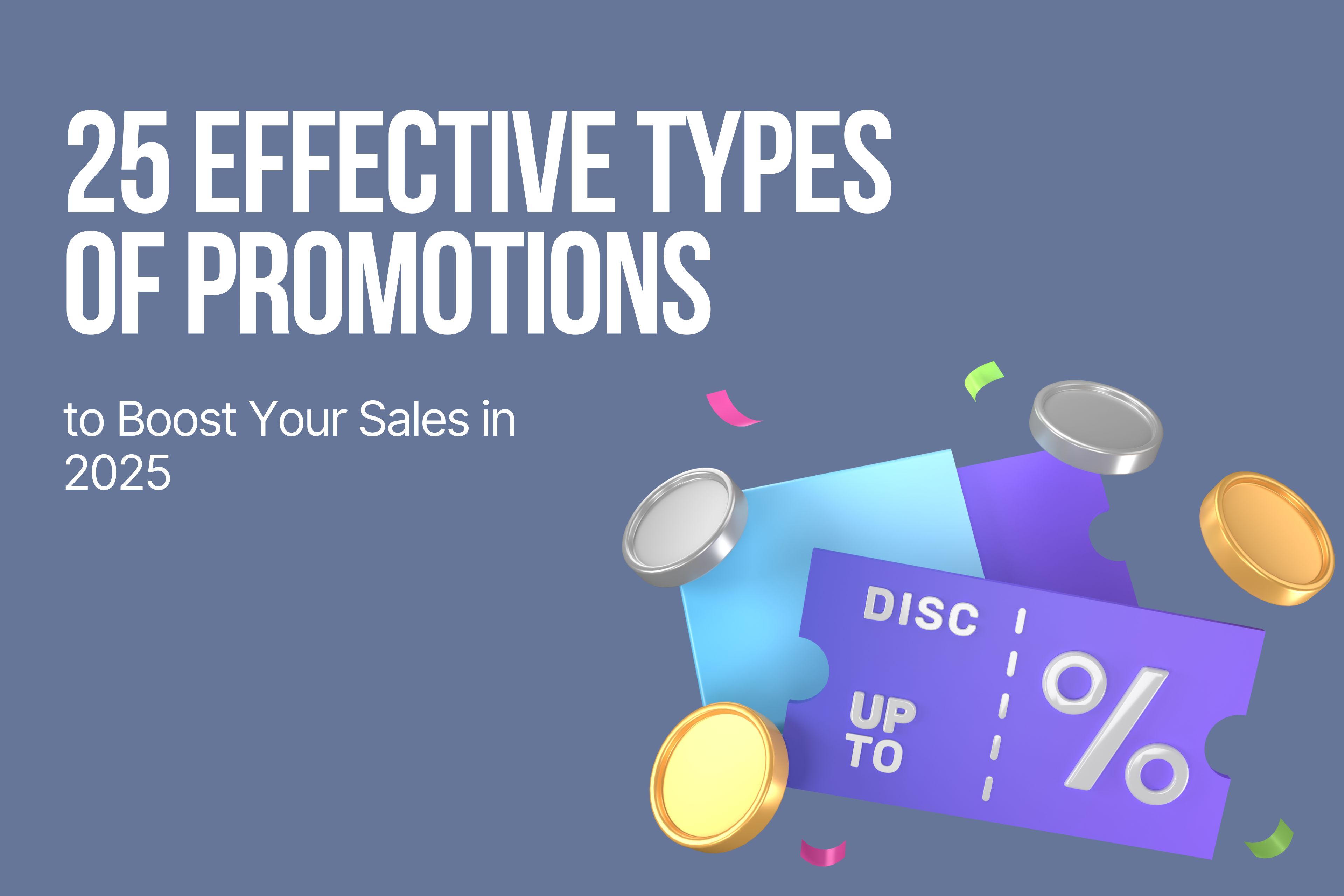Quick Summary by Popupsmart
Promotions are essential tools for capturing attention, increasing conversions, and building long-term customer relationships. In this guide, we explored 25 diverse promotion types from timeless tactics like coupons and flash sales to strategic approaches like loyalty programs, upsells, and PR campaigns. We also shared actionable tips on how to choose the right promotion type for your goals and offered best practices for running high-performing campaigns. Whether you're looking to boost short-term sales or nurture loyal customers, the key is aligning the right tactic with the right timing and audience. With the right tools—like Popupsmart—you can execute these strategies with precision, creativity, and measurable impact.
What Are Promotions in Marketing?
Promotions in marketing refer to short-term tactics used to increase customer interest and drive specific actions like purchases, sign-ups, or referrals. These strategies are typically part of a broader marketing mix and work alongside pricing, placement, and product efforts.
Promotions can be monetary (discounts, coupons) or non-monetary (free gifts, contests), and they’re used across channels including email, social media, websites, and in-store. Each type of promotion serves a unique purpose depending on the audience and business goals.
Why Promotional Strategies Matter
Without strategic promotions, even the best products can get lost in the noise. Promotions help brands:
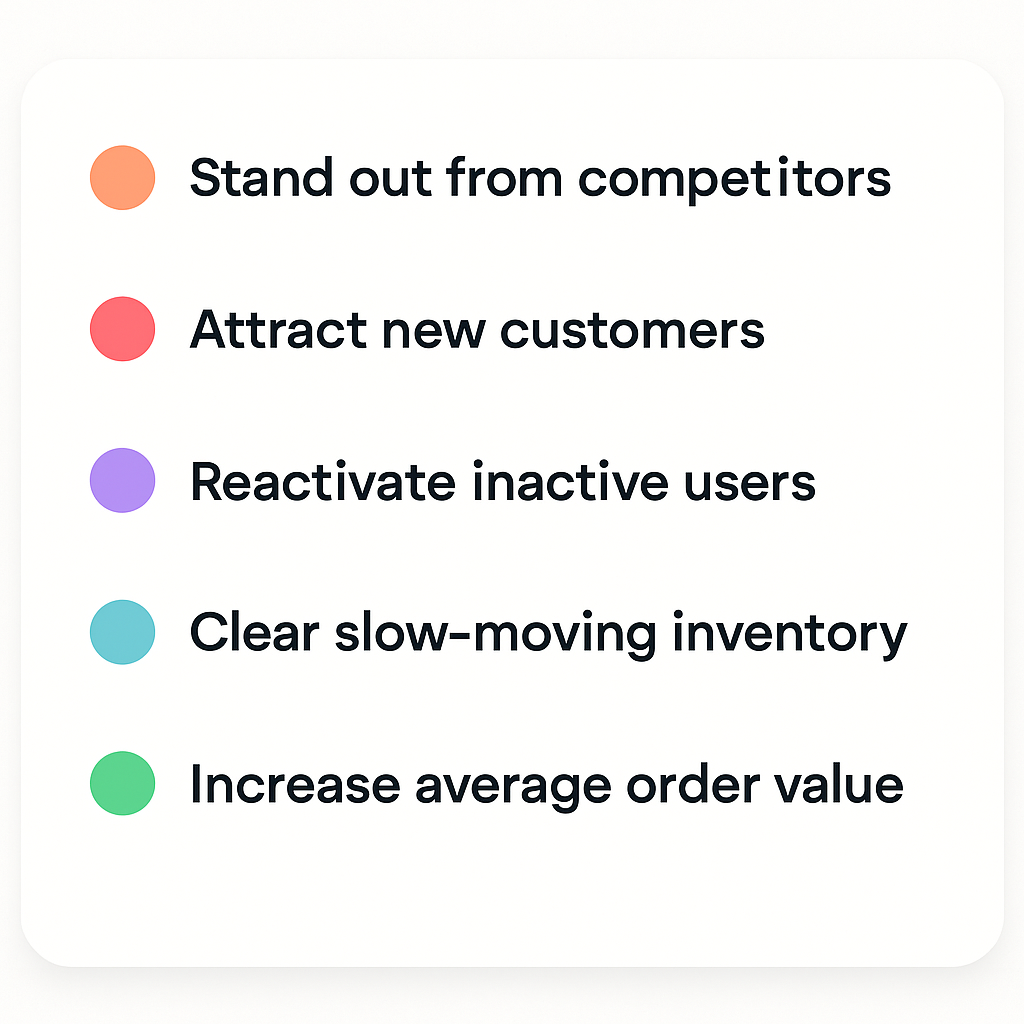
Well-executed promotions do more than drive short-term sales, they foster long-term customer loyalty when used wisely.
And when combined with behavioral tools like popups or exit-intent offers, the impact multiplies. For instance, Popupsmart users have seen significant uplift in conversion rates when combining loyalty programs with personalized welcome offers.
Types of Promotions
There’s no conventional way when it comes to promotions. Below, you’ll find 25 distinct types; each with its own strengths, use cases, and best practices.
Let’s start with the classics and work our way toward newer digital-first strategies.
1- Coupons
Coupons are among the oldest and most popular promotional tools. They offer customers a specific discount, either in percentage or fixed value, to incentivize purchases.
Benefits:
- Creates urgency
- Encourages first-time purchases
- Useful for re-engaging inactive users
2- Loyalty Programs
Loyalty programs reward repeat customers with points, perks, or exclusive offers, encouraging them to return again and again.
Why it works:
- Builds long-term customer relationships
- Increases lifetime value (LTV)
- Creates a sense of exclusivity
3- Free Shipping
Shipping costs are one of the biggest reasons for cart abandonment. Offering free shipping—either site-wide or based on a threshold—removes a key barrier to conversion.
Popular formats:
- Free shipping on all orders
- Free shipping over a certain amount
- Limited-time free shipping events
Example Strategy:
A popup can promote “Free Shipping This Week Only” to create urgency. Just make sure it's contextually placed and doesn’t feel intrusive.
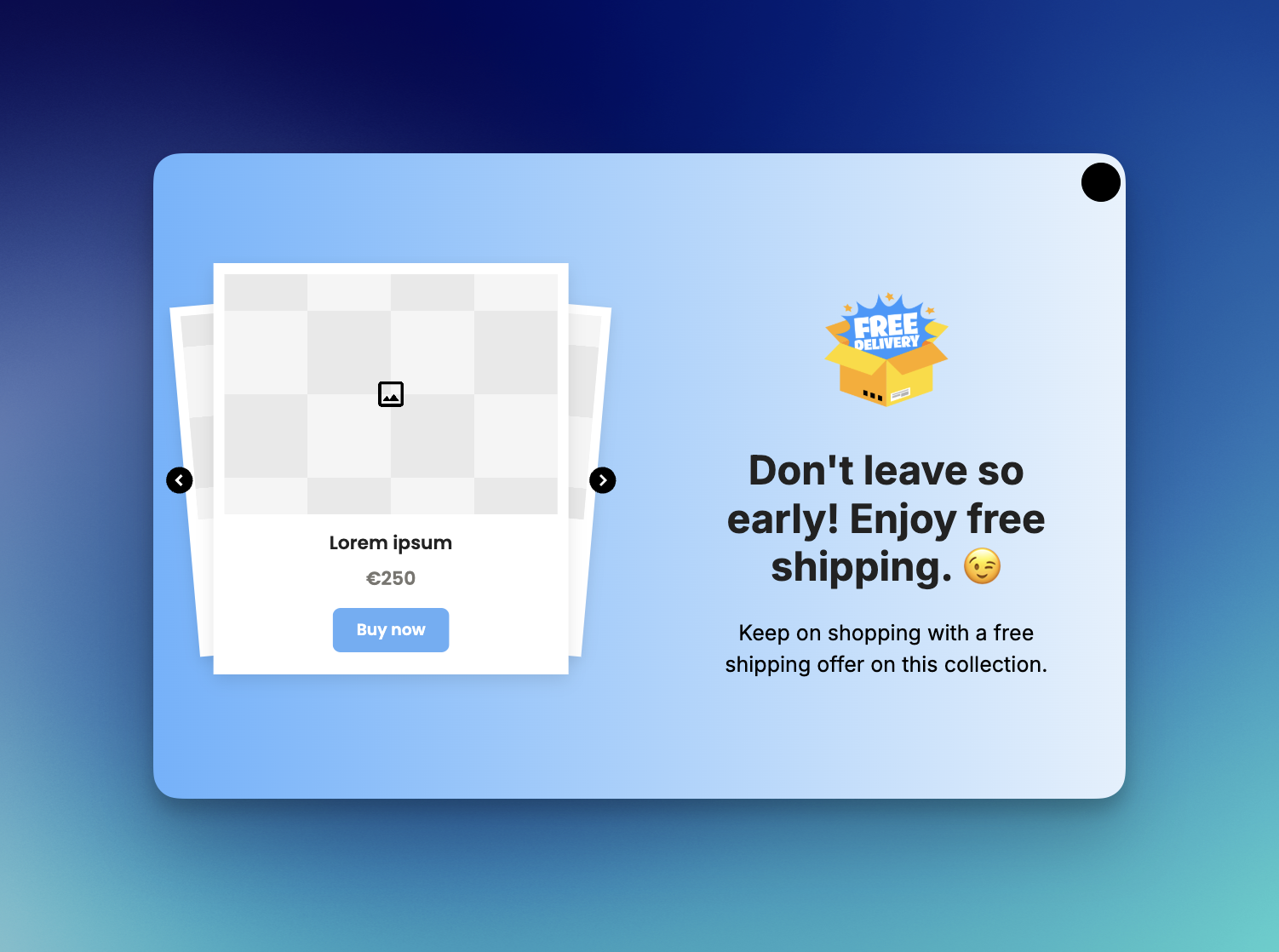
4- BOGO (Buy One Get One) Specials
Buy-One-Get-One deals are powerful for increasing volume and moving inventory. It’s a win-win: the customer gets more for their money, and you sell more units.
BOGO variations:
- Buy one, get one free
- Buy two, get one at 50% off
- Buy one, get a related item free
Pro Tip:
Pair BOGO promos with product-specific popups—like showing the offer when a user views an eligible item—to maximize relevance and conversion.
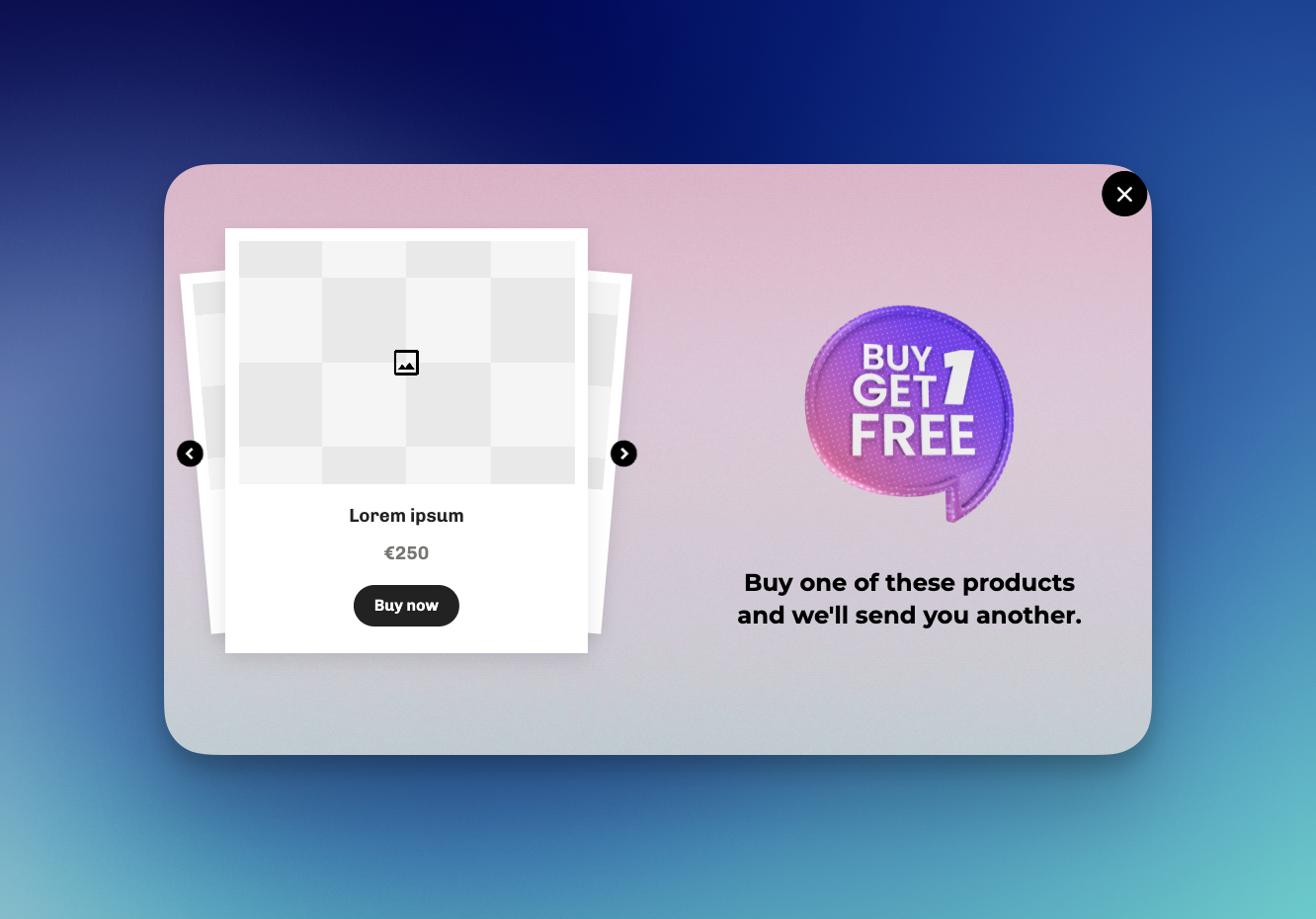
5- Flash Sales
Flash sales are limited-time offers that create urgency and drive quick decisions. Because they’re only available for a short window, they often lead to impulse purchases and a spike in traffic.
Key elements of a successful flash sale:
- Clear start and end time
- Countdown timers
- Highlighted scarcity (e.g., “only 3 items left!”)
Conversion Tip:
Popupsmart’s countdown timer popups are a subtle but effective way to visually communicate urgency. You can show a floating bar during the sale window that counts down in real time; no pushy messaging, just pressure that works.
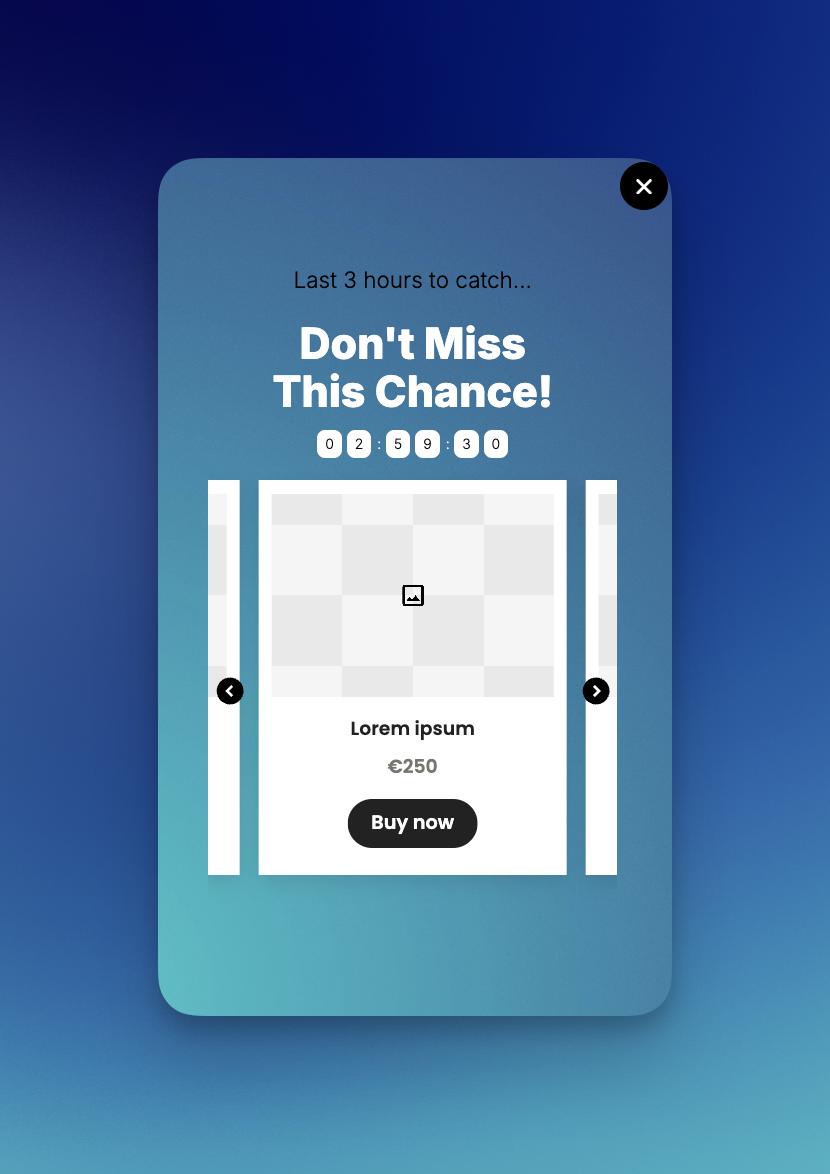
6- Referral Programs
Referral programs encourage existing customers to refer your business to friends in exchange for a reward—usually a discount, store credit, or a gift.
Why they work:
- Builds trust through word-of-mouth
- Cost-effective way to acquire new customers
- Turns happy users into brand advocates
7- Advertising
Advertising covers both traditional and digital media used to promote products or services. It includes paid ads on Google, social media, native platforms, and even print or TV.
Forms of advertising:
- Search engine ads (Google Ads)
- Display ads
- Sponsored content
- Social media ads (Meta, TikTok, X)
8- Percentage Discounts
Offering a set percentage off—such as 10%, 25%, or 50%—is one of the most straightforward promotions. It can apply to the whole store, specific categories, or even individual products.
When to use:
- To boost sales during slow periods
- As a welcome offer for new customers
- To reward email subscribers or loyalty members
Tip for Smart Timing:
Use exit-intent popups to offer a percentage discount to users who are about to leave your site without purchasing. It’s a final nudge that can save the sale.

9- Competitions
Competitions—or contests—are interactive promotions where participants engage for a chance to win a prize. They’re excellent for building brand awareness, collecting user-generated content, or growing your email list.
Popular formats:
- Social media contests (like/comment/share)
- Quiz or game-based competitions
- Submit-to-win (photo, story, idea, etc.)
10- Direct Marketing
Direct marketing involves targeting specific individuals with personalized promotional messages; typically via email, SMS, or direct mail. The goal is to create a one-on-one relationship that leads to measurable responses.
Strengths:
- Highly targeted and measurable
- Customizable to user behavior
- Ideal for re-engagement and retention
Best Practice:
If a user hasn’t purchased in a while, showing a personalized popup offering “10% off your next purchase, just for you” after login can make the outreach feel intentional and meaningful, perfectly aligned with direct marketing principles.
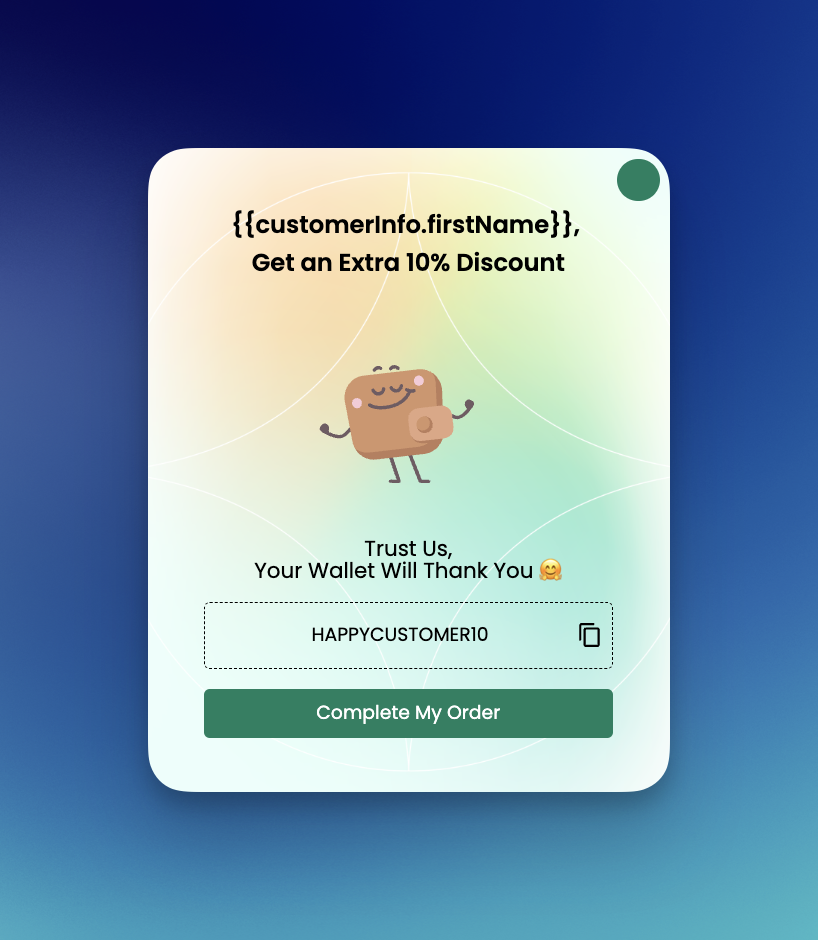
11- Giveaways
Giveaways involve giving away a product or service for free, often in exchange for small actions like signing up for a newsletter, tagging a friend, or following a page. They are especially effective for fast audience growth and brand visibility.
Benefits:
- Low-cost audience building
- Great for social media traction
- Creates buzz and anticipation
Practical Tip:
Popupsmart’s gamified wheel popups are ideal for this. For example, “Spin to Win a Free Product!”—users interact with the popup, making the giveaway feel exciting and fair, not just another data capture form.

12- Free Gifts
Offering a free gift with a purchase is a clever way to increase perceived value and encourage upselling. Unlike giveaways, free gifts are conditional upon an action—usually a minimum spend.
Common formats:
- “Get a free mug with orders over $50”
- “Buy one, get a surprise gift”
- “Free tote with any skincare product”
13- Subscriptions
Subscription-based promotions offer products or services on a recurring basis; weekly, monthly, or yearly. They're perfect for building predictable revenue and strong customer relationships.
Use cases:
- SaaS platforms
- Subscription boxes
- Media and streaming services
Promotion ideas:
- “Get your first month free”
- “Subscribe now and get a bonus item”
- “Annual plan = 20% discount + early access”
14- Donations
Cause-based promotions tap into customer values. You can offer to donate a portion of each purchase to a cause, or encourage users to make their own donation during checkout.
Why it works:
- Builds emotional connection
- Increases trust and brand affinity
- Aligns your brand with a mission
15- Email Marketing
Email marketing is one of the most cost-effective ways to stay in touch with customers. From welcome sequences to abandoned cart reminders, email-based promotions keep your brand top of mind.
Types of promotional emails:
- Time-sensitive discounts
- Product launches
- VIP-only offers
- Birthday rewards
Optimization Tip:
The most effective email promotions start with a strong list. Use Popupsmart to create a visually clean, incentive-driven popup like “Get 10% Off Your First Order – Join Our List!” Pair that with audience segmentation, and you’ve got a high-ROI machine.
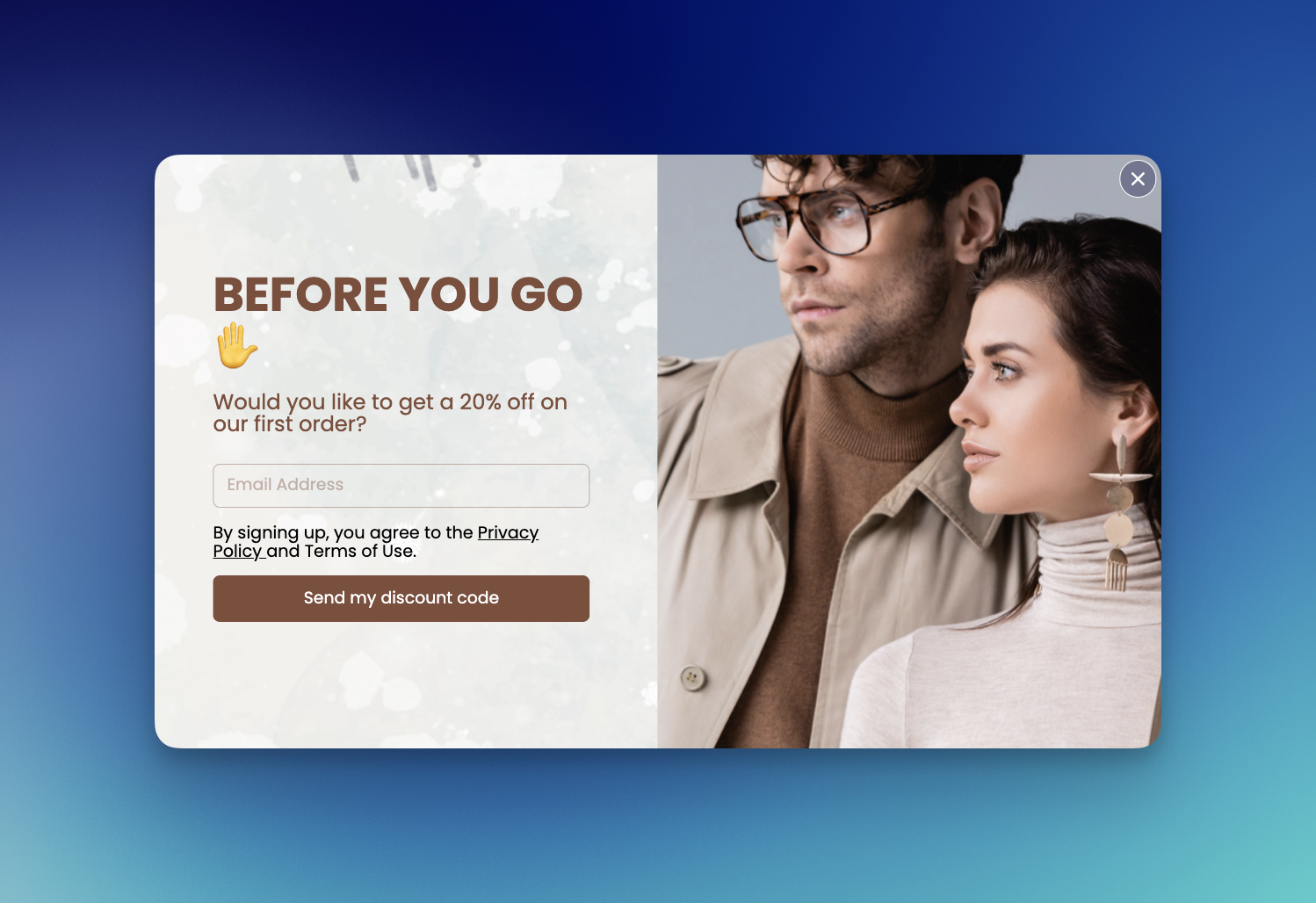
16- Free Samples
Free samples let customers try your product with no commitment. They’re especially powerful in industries like beauty, food, and health where experience drives purchase.
Benefits:
- Reduces purchase hesitation
- Introduces new products
- Builds trust through experience
17- Upsells
Upselling is the strategy of encouraging customers to buy a more expensive version of a product or add complementary items to increase the order value.
Example scenarios:
- “Upgrade to premium for 20% more features”
- “Add X to your cart and save 15%”
- “Customers who bought this also bought…”
18- Sales Promotion
Sales promotions are limited-time campaigns designed to create urgency and incentivize purchases. They can be planned around seasons, events, inventory levels, or even slow-performing products.
Common forms of sales promotions include:
- End-of-season sales
- Flash deals
- Clearance events
- Buy more, save more structures
These promotions are often visually bold and time-sensitive, aiming to nudge customers into quicker decisions. However, overuse can dilute their impact and potentially harm brand perception. That’s why it's essential to plan them strategically and communicate them with clarity.
One effective way to highlight a sales promotion is by using time-bound visuals such as banners or countdown timers; whether on your site, in emails, or on social media. These visual cues tap into FOMO (fear of missing out), one of the most powerful psychological drivers in marketing.
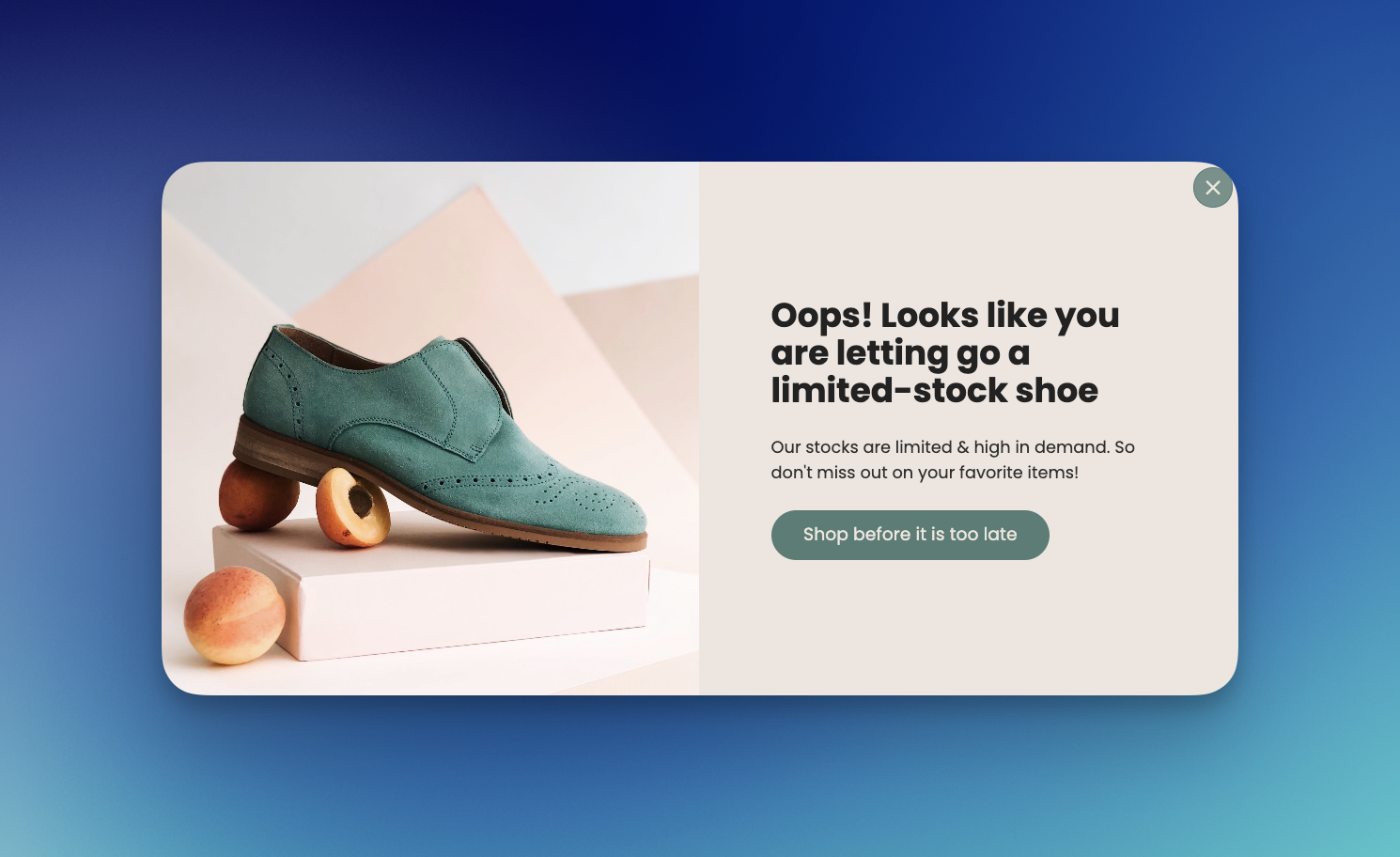
19- Public Relations
Public relations (PR) isn’t the first thing that comes to mind when discussing promotions, but it plays a powerful indirect role in shaping public perception and supporting sales efforts. PR campaigns don’t always lead to instant conversions, but they build trust, visibility, and authority, which can lead to more receptive audiences when other promotions are introduced.
Examples of PR-related promotions include:
- Press releases about new product launches
- Charitable contributions or partnerships
- Media coverage in reputable outlets
- Influencer collaborations
For example, if your product is featured in a major publication or endorsed by a known figure, that’s a promotional opportunity. Many brands smartly amplify this by featuring “As seen in...” sections on their homepage or in product pages.
20- Personal Selling
Personal selling refers to a one-on-one interaction between a sales representative and a potential customer. While it’s more commonly associated with B2B or high-ticket B2C items (like real estate or consulting services), it can also be adapted to digital environments through tools like live chat, video consultations, or demo requests.
The advantage of personal selling is customization. Sales reps can answer questions, address objections, and tailor offers to the buyer’s specific needs. This makes it ideal for complex or unfamiliar products where education and trust are essential.
In online contexts, a well-placed “Book a Free Demo” button or an embedded calendar within a contact popup can serve as the entry point to personal selling. However, for less intrusive approaches, live chat or support widgets may be more appropriate.
This promotional type shines when the focus is on relationship-building, not hard selling.
21- Product Bundles
Product bundling involves offering two or more items together, often at a reduced price. This strategy works exceptionally well for increasing average order value (AOV), moving slow stock, and introducing customers to products they might not purchase individually.
Examples include:
- “Buy 2, get 1 free” deals
- Starter kits (e.g., razor + extra blades + shave cream)
- Cross-category bundles (e.g., coffee machine + mug + beans)
The psychology is simple: people love a deal, and bundles give the feeling of getting more value for their money. They also reduce decision fatigue by helping customers avoid endless browsing.
22- Sponsorship
Sponsorships are promotional partnerships where a brand financially supports an event, individual, or organization in exchange for visibility and association. They’re common in sports, entertainment, community initiatives, and even digital content creation.
For example:
- A tech company might sponsor a developer conference
- A fitness brand might sponsor a marathon or athlete
- A SaaS brand might support a niche podcast for their audience
The benefits go beyond logo placement. Sponsorships provide targeted exposure, align your brand with certain values or lifestyles, and often generate positive brand perception.
23- Digital Advertising
Digital advertising is one of the most direct ways to promote a product online. It includes paid placements on platforms like Google, Facebook, Instagram, YouTube, X (Twitter), TikTok, and more. These channels allow for laser-focused targeting and instant results.
There are multiple ad formats:
- Search engine ads (Google Ads)
- Display ads
- Video ads
- Shopping ads
- Retargeting campaigns
The key to successful digital ads lies in message match, ensuring the landing page or promotion aligns with what was promised in the ad. If your ad says “Get 20% Off for New Customers,” the user should land on a page that honors exactly that.
This is one place where a popup can help reinforce the message without clutter. For example, if the user comes through a Facebook campaign, you can show a banner popup with the same discount and a countdown to create urgency. Popupsmart allows targeting based on UTM parameters, which makes this kind of message consistency easy to maintain.
24- Holiday Promotions
Holiday promotions are a staple of seasonal marketing. These promotions leverage the natural momentum of events like Black Friday, Cyber Monday, Christmas, Valentine’s Day, or Back to School to drive spikes in traffic and sales.
What makes holiday promotions unique is that consumers expect them. That gives you permission to be bold, creative, and even playful with your messaging. It’s also a chance to experiment with gift guides, exclusive bundles, and limited-time offers.
Examples of holiday promotions:
- “12 Days of Deals” countdowns
- Holiday-themed product bundles
- Free shipping for orders placed before a deadline
- Gift card promotions (Buy $100, get $10 bonus)
Make sure your campaigns are planned well in advance and have visual cohesion. Even something as simple as holiday-themed colors or illustrations can significantly increase click-through and engagement.
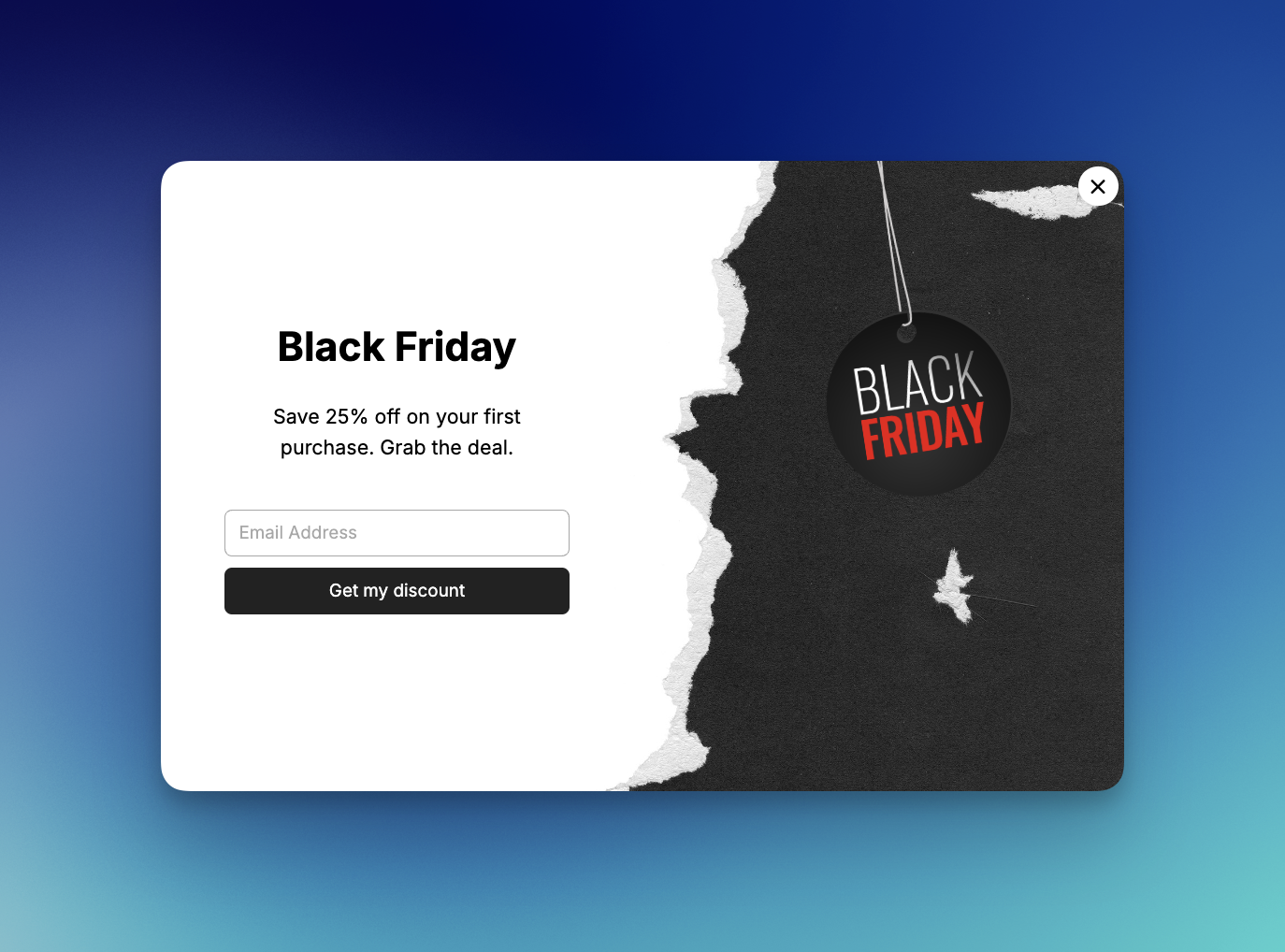
25- Influencer Marketing
Influencer marketing involves partnering with social media personalities or industry experts to promote your brand or product. This strategy provides access to large, targeted audiences and builds trust and authority for your brand. Influencers’ authentic relationships with their followers make their endorsements more credible and impactful.
Why it works:
- Directly reaches your target audience
- Builds social proof and trust
- Creates viral reach and fast brand awareness
How to Choose the Right Promotion Type
Choosing the right type of promotion isn’t about guessing, it’s about aligning your campaign with your business goals, audience behavior, and market conditions. A flashy discount might drive conversions, but is it sustainable? A giveaway might grow your email list, but will those users stick around?
Here are key factors to help you decide:
1. Define Your Goal
Are you looking to:
- Increase sales in the short term? → Flash sales, percentage discounts
- Grow your email list? → Giveaways, lead magnets
- Retain existing customers? → Loyalty programs, upsells
- Improve brand awareness? → Sponsorships, PR-based promotions
Clarity here helps you avoid mismatched tactics.
2. Understand Your Audience
Do they respond better to monetary incentives (e.g., discounts), or value-based ones (e.g., free gifts, causes)? Use past performance data and buyer personas to guide you.
For instance, Gen Z customers may engage more with gamified promotions and social media contests, while older segments might prefer email-exclusive coupon codes or bundle deals.
3. Consider Timing & Seasonality
Align your promotions with key dates, holidays, or even slower sales periods. A BOGO deal may be great for holiday shopping, but less effective during mid-season lulls. Don’t ignore external trends, your timing can make or break the campaign.
4. Match the Channel
Different promotion types thrive in different formats:
- Popups work great for immediate incentives (coupons, free shipping)
- Email campaigns are best for loyalty, upsells, and product drops
- Ads are ideal for flash promotions and giveaways
- On-site banners or product page offers work for bundles and upsells
5. Test and Iterate
Start with a small campaign and track metrics like:
- Conversion rate
- Revenue lift
- Bounce rate
- Coupon redemption
From there, you can tweak messaging, visuals, timing, or even the offer itself.
Frequently Asked Questions
What is the most effective type of promotion?
There’s no right answer. Flash sales and percentage discounts often bring quick wins, but loyalty programs and email-based promotions deliver better long-term ROI. The best type depends on your goal, audience, and timing.
How often should I run promotions?
Running them too frequently can lead to promotion fatigue and lower perceived value. Aim for balance; seasonal campaigns, occasional email offers, and evergreen bundles can keep things fresh without overwhelming customers.
Are popups effective for promotions?
Yes—when used thoughtfully. Popups should be context-aware, non-intrusive, and mobile-friendly. Offering value (e.g., a coupon or early access) in exchange for an email is one of the most effective ways to grow and convert your audience.
How do I measure the success of a promotion?
Key metrics include:
- Conversion rate
- Revenue from campaign
- Click-through rate (CTR)
- Average order value (AOV)
- Return on ad spend (ROAS) if paid traffic is involved
Use UTM links and analytics dashboards to trace the customer journey.
Conclusion
Promotions aren’t just about slashing prices, they’re about creating value, building relationships, and guiding your audience toward meaningful action. From limited-time flash sales to thoughtful loyalty rewards, each type of promotion has a place in your strategy.
What sets high-performing campaigns apart is how well they’re aligned with business goals, audience expectations, and execution quality. When you combine smart promotional tactics with user-friendly tools like Popupsmart, you unlock higher engagement, stronger retention, and more sustainable growth.
Now that you're armed with 25 types of promotions and all the insights to use them wisely, it’s your turn to take action. Start testing, keep optimizing and watch your conversions grow.
